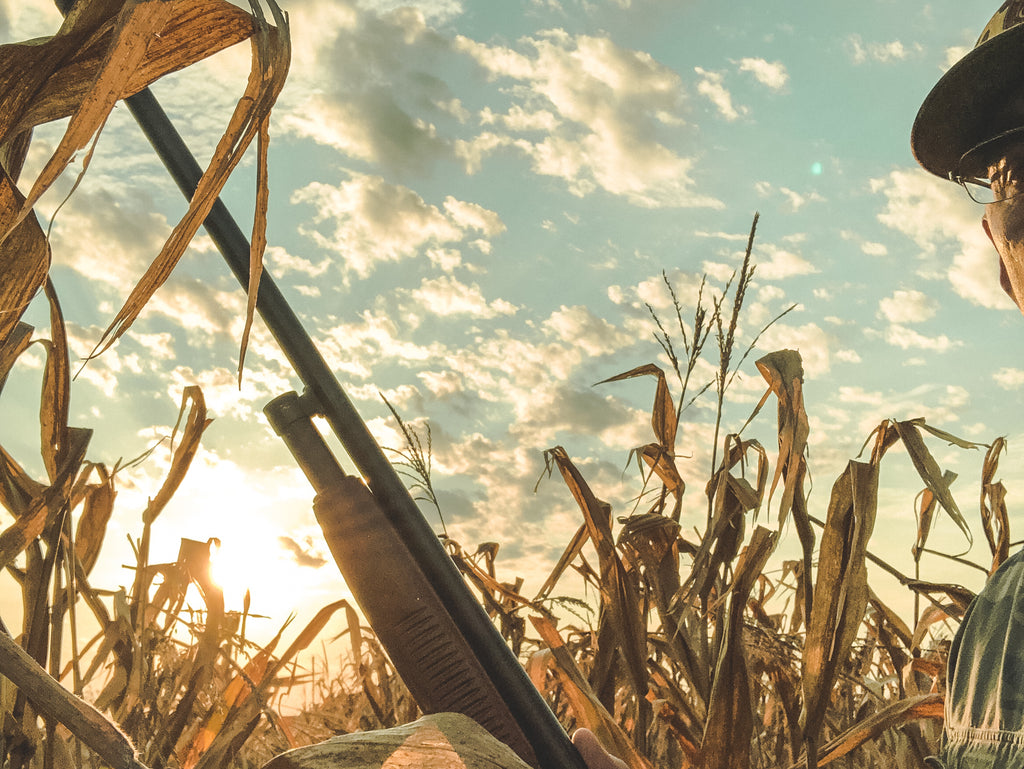Dove Hunting with a Department Store Shotgun

Grasping memories of my youth in the dove fields.
Standing in between the edge rows in a field of standing corn, I loosely grasped the wooden forend of the mid-1970s era shotgun. The shotgun felt strange in my hands. Unorthodox. Yet, the connection had been in the making for over 40 years. The same amount of time had passed for the slightly tight-fitting “brown duck” (Think Carhartt) colored game vest I had donned that morning. Yellow shells sat loosely in the outstretched dark brown shell holders on the vest. Was I grasping at memories?
No. Yes. Maybe. I had been inspired recently to take out the twenty-gauge shotgun of my youth. Accompanying the pump shotgun was the “no-thrills” bird vest I wore during the same timeframe. In this era of high-tech fabrics and materials, the feel of heavy canvas material was a journey back to my days afield with my father. I wanted to recreate or re-experience the use of these items.
The twenty-gauge shotgun had not been used, carried, or shot in decades. It stood as a silent sentinel in my father’s wooden gun cabinet. It had been abandoned or yet, replaced by semi’s then soon-after, double-stacked barreled shotguns. This relic of my youth was a Western Field Montgomery Ward M550CD, 20-gauge pump-action shotgun. Through a little research I discovered most models were manufactured through subcontracts. Many were made by Mossberg. The Western Field trademark has appeared on hundreds of shotguns sold through Montgomery Ward’s retail stores. Retail stores you ask. Yes, there was a time in America when one could go to a department store and shop for clothes, household appliances, furniture AND shotguns.

The Western Field shotgun was purchased at the local Montgomery Ward store in Olathe, Ks. in the late 1970s for $120.00. My mother said she had no idea as to what type of shotgun to buy.
The shotgun was her gift to my father on his birthday…September 1st. Ironic isn’t it that his birthday would become synonymous with the start of dove season. The date that signals the start of the upland bird season for those that have waited all year long to go afield. It was my father’s first shotgun upon arriving to the United States from Guatemala. He used the lightweight twenty-gauge pump as a waterfowl gun, as it would allow the use of three-inch magnum shells. Plenty to knock down ducks at the local wildlife management area where he and neighbor Tom would hunt from a camouflaged boat. The Western Field would be passed down onto me. I used it for small game hunting. I carried the shotgun when my dad began to delve into upland bird hunting. I used it near the border of Texas and Mexico as my family sat in lawn chairs shooting at passing doves. Gray birds would streak overhead flying over the orange groves. The shotgun held many memories.
I had been assigned as the unofficial caregiver for all the shotguns in my father’s gun cabinet. On occasion the twenty-bore would be taken out of its somber state and wiped down with gun cleaning oil. The mechanics behind the pump shotgun would be checked to make sure that if needed, the shotgun would be able to do its job at knocking down birds. A few yellow shells cycled through the gun to test ejection capabilities.
The thought of using the Western Field had never crossed my mind until recently. On a whim I decided to take out the shotgun. I unrolled the Sage & Braker gun mat and laid the Western Field onto its quilted wool surface. The shotgun offered absolutely no frills to onlookers. The wood on the little forgotten shotgun is in very good condition. There are some scratches and handling marks on the forearm and buttstock. The stories behind these worn markings had long been lost. Once inspected, it would be returned to its life of standing at attention with no future in sight to being carried in the field. Until now.
A week later, it was the start of the dove season. I gathered up my belongings for the dove field and bypassed grabbing my over-and-under. It was strange for me to not to instinctively reach for it. I had brought the Western Field home the day it received its routine cleaning. I gently slipped the twenty-gauge into its case.
I was curious as to how the 20-gauge shotgun would perform in the field. It had been many years since it had last seen any action. The drive was uneventful but full of anticipation. Dove hunting in Kansas is a smorgasbord of sights, sounds, and traditions.
I parked the truck grabbed the few tools needed for a couple of hours afield and walked to an edge of some standing corn rows. The sun had already started to rise. Its rays coloring the sky. The motion decoy was set up with a few plastic dekes spread out on the ground to lure overheard flying doves in. I cleared a spot in between some stalks to stand. It didn’t take long to get a looksy from some passing gray birds. I inserted two yellow shells and loaded one into the chamber with a confident “Thwack” of the pump forend. The shotgun’s adjustable C-Lect Choke on the barrel was set to CYL (Improved Cylinder). It had two additional settings; FULL and MOD. A trio of doves went screaming by at Mach 1. I stayed partially hidden until the birds turned towards the motion decoy. The Western Field slowly made its way towards the heavens. Its blued barrel positioned like a howitzer. The birds banked left, catching movement. It was too late. A string of pellets with hot steel knocked down the farthest flying dove.

It landed within feet of the mojo dove. I stepped out to retrieve my first September bird when I observed a small flock dipping and darting above the tree line opposite from me. They disappeared just as quickly as they appeared. Four steps out from the corn rows and the flock was on top of me! I shouldered the shotgun and fired the remaining shotshells. Miss. Hit. The hit bird sailed into the adjoining bean field enveloped in a sea of green vegetation. Marked. I went to it first and after several minutes of walking around and looking under plants, I found it. Its light pale gray underside with an almost pinkish hue lay belly up. The bird was placed into my ancient bird vest. Its five and-a-half ounces felt good against the small of my back. I added the other dove and returned to my perch.
Several more flocks appeared but none ventured close enough for shots. Down the rows I could see just above the tips of the corn stalks, singles and doubles were landing in the middle of the field. I usually opt to walk-up doves, but today I wanted to take in the use of the ol’ twenty. The morning was getting warmer. I wiped September’s sweet sweat slowly dripping down my face. Tributaries were running down my forearms. I could tell that a wet spot had developed from wearing my vest. I set the twenty-gauge down and removed the brown vest.
The Western Field was NOT an appealing shotgun to look at. It wasn’t meant to be. It was a “working man’s” gun. It was simple. Its one use was to knock down birds. And although it stood dormant for a long period of time, it quickly sprang into action declaring that it was worthy to be taken into the field. Its blue receiver was plain with no markings or fancy details. It reminded me of a glossy chalkboard if there was such a thing. Even the color of the wood was unattractive. However, the department store shotgun had a simplicity about it.

My thoughts quickly disappeared as a summer morning breeze rattled the corn stalks. I grabbed the shotgun as a group of mourning doves quickly flew over, turning on a dime, and dropped into my spread. Pop, Pop, Pop, announced their arrival. Yellow shells ejected out, falling to the bare ground between the corn rows. The smell of spent shotshells smoke curling up cleanly out of the ejection port on the last pump. Two doves had not continued flying with their brethren. The light heft of a dove in my hand as I bent down to pick it up – admiring its gray feathered plumage. Dreams of dove breasts stuffed in peppers wrapped in bacon over a grill made my mouth water.
It had turned into a grand morning. The sky had begun to turn blue, its pink blush was fading. I opened a fresh box of dove shells and loaded the shotgun. A few were placed into my pant pockets. Time crept by. As I stood, I thought of the Western Field standing for years without ever being noticed. Never being picked. It was akin to being like the last kid chosen for a team. Movement caught my eye. A lone dove flying. It didn’t know it, but its life was in peril. The tang mounted safety was moved to off. The mojo’s wings flickered. The flash of white probably caught the dove’s attention to doves feeding.
The gray ghost rockets by as I mount the shotgun, barrel swinging smoothly leading the bird. The trigger is pulled and the collision of shot pellets impacts against its soft and delicate body. The aroma smells pleasant as it lingers. The dove is added to my growing pile.
The morning ends with no other doves taken. It may have not been the biggest hunt, nor was the action fast and futile, but in many ways, it ranks among the very best that I have had. All because I decided to take my father’s first shotgun out. It had long been ignored. It was good to hold it in my hands. It functioned flawlessly. It had for a long time been the “little orphan Annie” of my father’s gun cabinet. I walked back to the corn rows and stood…waiting, just like the shotgun stood waiting for a little bit of action. The Western Field will be returned to its position within the gun cabinet, but its wait will be a lot shorter for when it is again chosen instead of the others to be carried into the field. The department store shotgun still has plenty of life in it to knock down birds…
Written by Edgar Castillo
